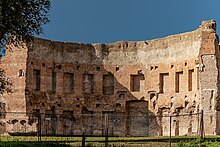Thermae of Trajan
The Trajan Baths were an ancient thermal baths in Rome and were built next to the Titus Baths , which from then on put them in the shade with their size, so to speak. At the time of their inauguration on June 22nd, 109 AD, the Trajan Baths were the largest baths in Rome. Later they were only surpassed by the Baths of Caracalla and the Baths of Diocletian . The complex was partly built on a wing of the Domus Aurea , the rooms of which were filled in after being destroyed by fire in 104 in order to obtain a flat level on the slopes of the Esquiline for the huge complex. Some of the buried rooms of the Domus Aurea remained accessible as the basement of the thermal baths. According to a statement by Cassius, the architect is assumed to be Dio Apollodor of Damascus , who also planned the Trajan's Forum for Trajan .
The entire system was about 330 by 315 meters, the central building about 190 by 212 meters. Compared to the previous imperial thermal baths, the Trajan thermal baths had a kind of park for the first time, in which the actual thermal baths were located and which was surrounded by a wall. The emperors Caracalla and Diocletian then more or less copied this complex by building similar thermal baths. The Trajan thermal baths are oriented somewhat differently than the Titus thermal baths in order to enable better use of the solar radiation.
A gateway in the north formed the entrance to the thermal baths. To the right and left of an open courtyard with a swimming pool (natatio) were two building parts with halls in mirror image, in the south of the courtyard the actual bathing complex with caldarium, tepidarium and a basilica.
Today there is little to see of the thermal baths. In the park on the Oppius, one of the ridges of the Esquiline , some remains have been preserved. A reconstruction is possible using a section from the Urbis format . A few years ago, further remains of the Domus Aurea were discovered beneath the large, very well-preserved western exedra of the enclosure wall. A remarkable fresco of a fortified city came to light on a wall used as a substructure for the thermal baths above .
literature
- Erika Brödner: The Roman thermal baths and the ancient bathing system: a cultural-historical consideration . Theiss, 1997.
- Filippo Coarelli : Rome. An archaeological guide . Zabern, Mainz 2000, ISBN 3-8053-2685-8 , pp. 226-227.
- Samuel Ball Platner , Thomas Ashby : Thermae Traiani . In: dies .: A Topographical Dictionary of Ancient Rome . Oxford University Press, London 1929, pp. 534-536 ( online ).
Web links
Remarks
- ^ Cassius Dio 69, 4, 1 ( English translation ).
Coordinates: 41 ° 53 ′ 30.7 " N , 12 ° 29 ′ 46.6" E



